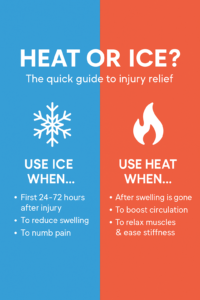It’s a question as old as time—heat or ice? If you’ve ever suffered a sore muscle or a sudden injury, chances are you’ve been given advice (sometimes conflicting) on whether to reach for a heating pad or a bag of frozen peas. Some swear by the soothing warmth of heat, others are all about the numbing effects of ice. And then there are those who say, “Just go with what feels best.”
But if you’re trying to make the most informed decision for your body, it’s worth understanding why heat and cold each have the effects they do—and when to use them.
What Happens When You’re Injured?
When you suffer a sudden (acute) injury—think sprained ankle, pulled muscle, or a fall—your body jumps into repair mode. For the first 24 to 72 hours, it sends extra blood flow to the area. This brings oxygen and healing agents to start breaking down damaged tissue and forming scar tissue.
From the outside, this shows up as swelling, warmth, and pain. Although this response is natural and helpful, too much swelling can actually harm nearby healthy tissue and worsen the injury.
When to Use Ice
This is where ice comes into play. Cooling an area causes blood vessels to constrict (a process called vasoconstriction), which reduces blood flow. This helps manage swelling, slows down inflammation, and numbs the area to reduce pain signals.
That’s why ice is traditionally recommended during the first 48–72 hours after an injury. The goal is to prevent excessive swelling and give your body a chance to stabilize the injury before healing can truly begin.
When to Use Heat
After the initial inflammation phase has passed (usually a few days in), heat can become your new best friend. Heat causes blood vessels to dilate, increasing circulation to the area. This brings in oxygen and nutrients that help tissues heal, while flushing out waste products.
Heat can also relax tight muscles, ease stiffness, and generally promote a sense of calm and comfort—all of which can contribute to reduced pain.
This phase of healing, where your body is rebuilding tissue and strengthening the area, can continue for months or even up to a year. During this time, heat therapy may support your recovery and improve mobility.
So… Which One Should You Use?
Here’s the tricky part: science doesn’t fully agree.
While conventional wisdom still supports ice for immediate injuries and heat for later stages, recent research has questioned the benefits of cold therapy—even in the early hours post-injury. Some studies suggest that ice might actually slow down tissue repair by interfering with the body’s natural healing response.
In other words, despite decades of guidance, there’s still no definitive answer.
Bottom Line
The decision to use heat or ice often comes down to a balance between what stage your injury is in and what your body is telling you. Here are some general guidelines:
- Use ice: During the first 24–72 hours after an acute injury to manage swelling and pain.
- Use heat: After the swelling has gone down to increase circulation, ease stiffness, and support ongoing healing.
- Use your judgment: If something feels good and provides relief without making symptoms worse, that’s valuable information too.
Ultimately, knowing why you’re using heat or ice gives you more control over your healing. While the research continues to evolve, tuning into your body and understanding the effects of each can help you make the best choice for your situation.
Disclaimer: Always consult with a healthcare provider if you’re dealing with a serious injury or chronic pain condition.

